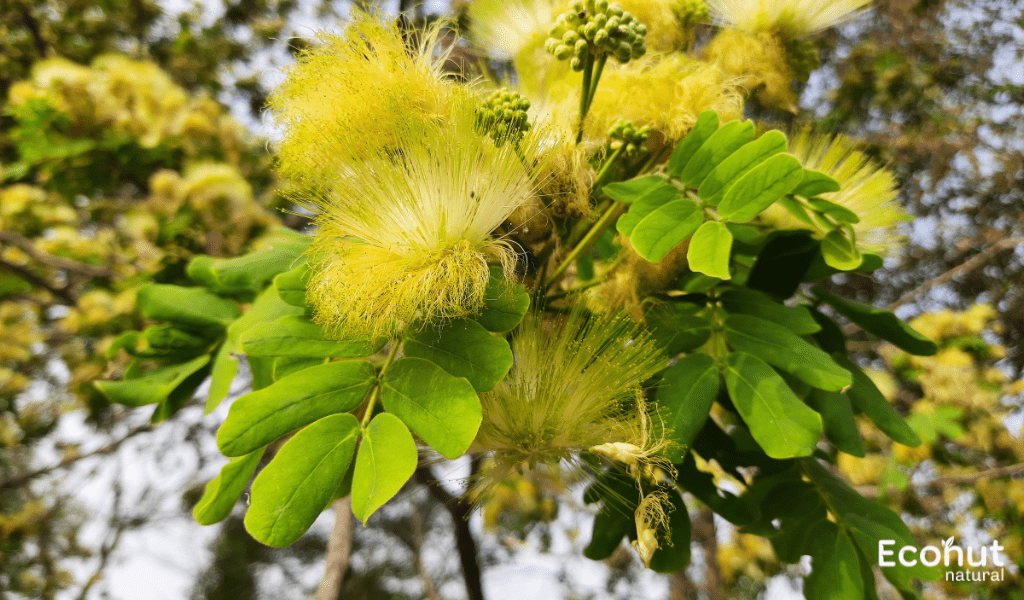Originating in Indomalaya, New Guinea, and Northern Australia, shirish(Albizia lebbeck) trees are extensively naturalized or farmed in many tropical and subtropical areas. In Southern India, the tree gets to be rather large and is plainly seen by the sides of the road. One of the key anti-poisoning herbs for treating snake bite poisoning is this one.
Shirish has a slight hot intensity and is dry, biting, bitter, astringent, sweet, and pungent. It is also easy to digest. Shirish leaves, flowers, bark, and seeds are all utilized medicinally.
Description
A deciduous tree native to cities is called Siris. This medium-sized tree produces high-quality wood. Ayurvedic medicine uses every component of the plant. The tree appears frequently in texts written in ancient Sanskrit.
Botanical name:
Albizia lebbeck
Family:
Legumes-Mimosoideae
Height:
The Shirish tree has a maximum height of 18–30 meters (59–98 feet)
Leaves:
Leaves undergo two divisions. They feature one to four pairs of pinnae and measure 7.5–15 centimeters (3-6 inches) in length. There are 6–18 leaflets per pinna. The leaflets measure 1.5–6.5 centimeters (0.6–2.6 inches) in length and 0.5–3.5 centimeters (0.2–1.4 inches) in width. They have an oblong to elliptic-oblong form.
Flowers:
White and fragrant, the flowers are borne in big, globular clusters that measure 5-7.5 cm (2-3 inches) in width. There are 15–40 flowers in each cluster, and each blossom has many long, white filamentous stamens. There is a lovely sent to the blossoms.
Fruits:
A pod measuring 15-30 centimeters (6-12 inches) in length and 2.5-5 cm (1-2 inches) in width is the fruit of the Shirish tree. When fully grown, the pods have a feel akin to papery leather and range in color from pale straw to light brown.
Seed:
The Shirish tree (Albizia lebbeck) produces oval, brown, and flat seeds. They measure roughly 0.4 to 0.6 cm (0.2 to 0.2 inches) in width and 0.8 to 1.2 cm (0.3 to 0.5 inches) in length.
Parts Used:
Bark, Seeds, Leaves, Fruits
Chemical constituents:
Lebbeck is composed of a variety of phytochemicals, such as terpenoids, main alkaloids, flavonoids, and saponins.
Dosage:
- Powder – 3-6 gm
- Juice – 10-20 ml
- Decoction – 100 ml
Other Species of Shirish
- Lucida
- Procera
Botanical Description
The tree reaches a height of 50 to 80 feet, with a trunk that is wrinkled, and oblong leaves that are up to 6 inches long and 4 inches wide. The leaves are arranged in four or six whorls around the stem, with the nerves running at an angle to the mid.
Other Language Names of Shirish (Albizia lebbeck)
Sanskrit name – Shukriya. Kapitana, Mrudupushpa,Bhandi
Hindi name – Siris
English name – Flea Tree, Lebbek Tree
Telugu name – Dirisena Chettu
Tamil name – Vaagai
Malayalam name -Nenmenivaga
Punjabi name – Siri, Shari
Kannada name – Bage Mara
Gujarati name -Sarsado
Marathi name – Siras
Bengali name –Sirosh
Shirish (Albizia lebbeck) Classification
Kingdom – Plantae(Plants)
Order – Fabales(Legume Order)
Family – Fabaceae(Legume or Bean family)
Genus – Albizia
Ayurvedic Properties
Guna(Quality) – Laghu (light), Ruksha(dry),Tikshna (piercing)
Rasa (Taste) – Kashaya (astringent)
Virya (potency) – Lshad ushna (slightly hot)
Vipaka(after taste) – Katu (pungent)
Medicinal Uses of Shirish
Decoction:
Boil the bark or leaves of Shirish in water to prepare a medicinal infusion. To make it, boil a cup of water with around a teaspoon of dried Shirish bark or leaves until the water reduces by half. The infusion should be strained and consumed while still warm. This technique is very helpful for respiratory and intestinal disorders.
Powder:
There is a way to powder the dried bark of Shirish. You can eat this powder by mixing it with water, ghee, or honey. Half to one teaspoon of Shirish powder, once or twice a day, is the standard dosage, though this can vary. It’s frequently helpful in treating stomach issues.
Shirish (Albizia lebbeck) Benefits
Shirish for Inflammation and Pain:
When taken orally, compounds in shirish bark extract considerably lower inflammatory cytokines and enzymes linked to headaches, muscle soreness, arthritis, and inflammation.
Shirish for Allergy and Asthma:
Shirish exhibits antihistaminic properties in allergy models, which inhibit the immune system from overreacting to allergens. Additionally, it eases the smooth muscle of the bronchi to widen asthmatic airways.
A Superb Herb for spring, Autumn, and Year-Round Use:
Albizia has been shown in scientific tests to be effective in stabilizing mast cells. White blood cells called mast cells are a component of the immune system and help the body fight against diseases and allergies. Mast cells release a variety of chemicals, including histamine, which is essential to the body’s inflammatory response.
Digestive Health:
Shirish’s bitter and astringent flavors promote the release of digestive enzymes, which aids in better digestion. For those who experience digestive problems, like indigestion and bloating, it is frequently advised.
Skin Care:
Shirish leaves and bark provide calming and cooling qualities those make them effective in cosmetic products. They can aid in the relief of allergies, psoriasis, and eczema-related skin irritations.
Diabetes Management:
According to certain studies, Shirish may help control blood sugar levels, which means that those with diabetes may find it beneficial. It may help to stabilize the metabolism of glucose.
Respiratory Support:
It is advantageous for respiratory well-being. Its calming and anti-inflammatory qualities can aid in the relief of bronchitis, asthma, and cough symptoms.
Also Read: Gambhari (Gmelina arborea): Benefits and Side Effects
Shirish (Albizia lebbeck) Side Effects
Drowsiness:
Shirish’s propensity to make people drowsy is one possible cause for concern. Some of the plant’s constituents are responsible for this effect. It is advised to avoid Shirish or use additional caution if you are using machinery, driving, or performing other tasks that call for attentiveness.
Pregnancy and Breastfeeding:
Owing to the dearth of thorough studies on Shirish’s safety during pregnancy and lactation, it’s best to err on the side of caution and refrain from using it at all during these periods. It is always advised to speak with a healthcare provider before taking any herbal remedies when expecting or nursing a baby.
Medication Interactions:
Certain drugs, especially sedatives that increase sleepiness, may interact with Shirish. Medications known as sedatives soothe the nervous system and encourage sleep. Shirish and sedatives together may increase drowsiness to a risky degree. Consult your doctor before using Shirish if you take any drugs, especially sedatives, to prevent any potential interactions.
Conclusion
It has been demonstrated that Albizzia lebbeck has antihistaminic properties. Significant alleviation from bronchial asthma has been demonstrated in clinical trials using the bark. In one trial, the guinea pigs were considerably protected from 1% Histamine-induced bronchospasm by the bark decoction at doses of 0.25g to 1.0 g/kg.
FAQS
What is the flavor and aroma of shirish?
The taste of shirish bark and blossoms is astringent and slightly bitter, like green tea. Many people describe it as having a deep, slightly resinous fragrance.
What is the purpose of Albizia lebbeck gum?
It has been widely suggested that Shireesha be used to counteract toxins in the body. Additionally, it has been used to treat respiratory conditions such bronchial asthma.
Is it safe to use shirish continuously?
Yes, shirish has a long and safe history of use as a tonic herb that can be taken regularly for months or years to support holistic therapeutic benefits without running the risk of addiction.
What is the purpose of Albizia lebbeck powder?
Albizia is taken orally for the treatment of cancer, anxiety, depression, sleeplessness, sore throats, mood enhancement, and trauma-related edema. Albizia is administered topically to bug bites, ulcers, fractures, sprains, and skin infections (boils and abscesses).

